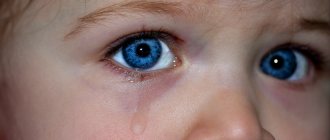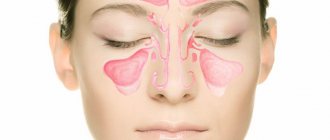Shine in the eyes from fatigue
Prolonged work at a computer monitor leads to the appearance of shine in the eyes. This symptom signals the need to take a break or get away from work for a few days. Prolonged work with small particles also leads to the appearance of shine in the eyes, which indicates overfatigue of the visual apparatus. The organs of vision become glassy even after watching TV for a long time.
Due to overwork of the visual apparatus, ophthalmological abnormalities may appear, which can provoke a decrease in visual acuity. Prevention of eye shine from fatigue includes:
- daily eye exercises;
- restorative masks for the eyelid;
- breaks from work every hour for a few minutes.
Diseases whose symptom is shine in the eyes
The appearance of shine may indicate the presence of diseases of the visual apparatus:
- Keratitis. Irreversible dystrophic processes in the cornea lead to complete or partial loss of visual function. Pathology develops against the background of infectious, inflammatory processes or injuries. The development of keratitis can be triggered by an allergic reaction or chemical poisoning. In addition to the shine in the eyes, clouding of the cornea, the sensation of foreign particles in the area of the organs of vision, and photophobia are possible.
- Conjunctivitis. The disease is accompanied by hyperemia, inflammation or pain. Before severe symptoms, a shine appears in the eyes, which indicates an infectious lesion of the visual apparatus.
- Dystrophic processes in the cornea. Genetic pathologies can cause reactions. Dystrophic changes and blurred vision are not interrelated and can develop independently of each other.
Graves' disease - causes, symptoms, treatment and prevention
Graves' disease (or Graves' disease, diffuse toxic goiter) is a disease characterized by an increase in the activity of the thyroid gland, an increase in the size of this gland due to autoimmune processes in the body.
With goiter, an enlargement of the thyroid gland due to the rapid proliferation of cells in this gland.
As a rule, this disease is associated with a lack of iodine in the body.
Graves' disease is one of the most common thyroid diseases. Although cases of this disease are less common than hypothyroidism, it is still in second place after it among thyroid diseases.
Graves' disease, in many cases, is transmitted hereditarily through the female line. Most often, the disease is transmitted through generations - from grandmother to granddaughter.
Causes of Graves' disease
As mentioned above, Graves' disease is an autoimmune disease.
It is the result of defects in the immune system, which begins to produce substances that interfere with the normal functioning of the body .
Diffuse goiter is characterized by the fact that lymphocytes begin to produce an abnormal form of protein, which has a stimulating effect on the thyroid gland. This protein is called a “long-acting thyroid stimulant.”
Diffuse toxic goiter is a very common disease (1 patient per 100 people). Most often it affects young and middle-aged women.
The causes of this disease can be different:
- long-term chronic infections in the body;
- hereditary predisposition.
Viral infections
Toxic goiter can appear as a result of various viral infections.
Radioactive iodine
Radioactive iodine (used as a test) can also cause this disease.
Very often, chronic tonsillitis .
Also, Graves' disease can appear in patients:
- diabetes mellitus;
- Addison's disease;
- vitiligo;
- hypoparathyroidism.
Signs of diffuse toxic goiter
The symptoms of Graves' disease are almost the same as those of hypothyroidism, which in many cases is the initial form of the disease.
General symptoms
The disorder is characterized by symptoms such as:
- vomit;
- nausea;
- enlargement of the thyroid gland.
The patient experiences a feeling of heat even during cold weather.
Early symptoms of Graves' disease
In the early stages of the disease, there are almost no visible symptoms. Graves' disease (Graves' disease) in many cases has individual symptoms, which makes it difficult to determine the correct diagnosis. Among the first symptoms you may notice:
- sleep disturbance,
- trembling fingers,
- palpitations,
- increased sweating,
- mood swings.
More common symptoms include:
- poor heat tolerance;
- weight loss (even with a normal diet).
Changes at eye level
Modifications in the eye area are considered a specific symptom of Graves' disease :
- pronounced shine of the eyes;
- rare blinking;
- Dalrymple's sign (eyes wide open).
Other signs may appear, such as eye damage :
- enlargement and protrusion of the eyes (bulging eyes);
- feeling of “sand” in the eyes, double vision.
- When looking down with eyes open, a white stripe appears above the pupil. In a healthy patient, this does not happen because the eyelids, as usual, follow the eyeball.
- In patients, an enlargement and protrusion of the eyeball is noticed.
- sometimes, the eyelids are characterized by swelling.
- Malnutrition of the eyes can cause various eye infections - inflammation of the mucous membrane of the eye ( conjunctivitis ).
- the nutrition of the eyeball is disrupted, optic neuritis appears. As a result, the patient may experience blindness .
As the disease progresses, the patient's tremors become more noticeable throughout the body. The skin becomes moist and patients become fidgety. The skin throughout the body takes on a dark tint, and is more pronounced in the eyelid area. In some cases, the skin in the area of the legs and feet thickens in the form of dense swelling.
The volume of the thyroid gland increases and becomes more noticeable. When palpated, it is dense and pain is not felt.
Cardiovascular system disorders
One of the most severe manifestations of diffuse toxic goiter is considered to be disorders of the cardiovascular system. The patient begins to have problems such as:
- heart rhythm disturbances;
- rapid heartbeat (even during sleep).
Many older patients often experience angina attacks . An increase in blood pressure is noticed. This disease can cause heart failure, which can be fatal .
Increased gastrointestinal motility
Increased activity of the thyroid gland increases the motility of the gastrointestinal tract. The following symptoms appear:
- nausea;
- diarrhea and vomiting (less often).
Liver problems
An excess of thyroid hormones can damage the liver because they have a toxic effect on this organ. , fatty liver develops .
Nervous system dysfunction
A high concentration of thyroid hormones in the blood can affect the functioning of the central nervous system. Thus, conditions such as:
- insomnia;
- dizziness;
- headache;
- anxiety states.
Impotence and infertility
With an overactive thyroid gland, dysfunction of other endocrine organs and even the gonads is also observed.
In men, potency decreases . For women, the situation can become more complicated because menstruation irregularities and even infertility are noticed.
Sugar metabolism disorder
There is a decrease in the production of hormones by the adrenal cortex and impaired glucose metabolism. Because of the latter, the patient is at risk of developing diabetes.
Stages of Graves' disease
There are three stages of Graves' disease:
First stage
During the first stage, the patient feels well.
- The purity of heart contractions does not exceed 100 beats per minute.
- The patient experiences a 10% weight loss.
Middle stage
- During a moderate degree of the disorder, the pulse rises above 100 beats per minute.
- Blood pressure also increases and weight decreases by 20%.
Severe stage
- The severe stage is characterized by a weight loss of more than 20%, the pulse rises above 120 beats per minute, and side effects of the disease on other organs are noticed.
Diagnosis of Graves' disease
The diagnosis of Graves' disease is based on:
- clinical picture;
- ultrasound examination;
- palpation of the thyroid gland;
- analysis of the concentration of thyroid hormones in the blood.
Drug treatment
Graves' disease is treated with medication.
The main prescribed drugs that suppress the activity of the thyroid gland are thyrostatics :
- propicyl;
- carbimazole;
- thiamazole.
At the onset of the disease, high doses of drugs are used, which are reduced over time. Treatment of the disease is carried out by monitoring the level of thyroid hormones in the blood until all signs of Graves' disease disappear (at least a year).
Also applicable:
- beta blockers;
- glucocorticoids;
- immunocorrectors;
- levothyroxine.
Surgical intervention
If drug treatment does not help, then surgical treatment is performed. Thus, part of the thyroid gland is removed.
Removing part of the thyroid gland does not eliminate the cause of the disorder .
Treatment with radioactive iodine
Another method of treating Graves' disease, when medications are ineffective, is treatment with radioactive iodine.
https://www.youtube.com/watch?v=5iqQgI8KGuc
This technique is not suitable for young people of childbearing age, but is perfectly suitable for older people.
Radioactive iodine, entering the body, damages the cells of the thyroid gland and, as a result, the activity of this gland decreases.
During treatment of the disease, you need to reduce the amount of foods rich in iodine and not take iodized salt. Sunbathing during treatment is also not recommended, because there is a risk of making the treatment ineffective.
Prevention of diffuse toxic goiter
Prevention of the disease consists of the following measures:
- lifestyle control;
- health monitoring;
- timely treatment of chronic and viral infections.
They, in many cases, can become the causes of Graves' disease.
You can't be nervous and sunbathe.
Stress can only cause harm.
Graves' disease manifests itself most often at the age of 30 - 40 years, which is why it is recommended to visit an endocrinologist more often .
link:
Source: https://www.net-bolezniam.ru/bazedova-bolezn-prichiny-simptomy-lechenie-i-profilaktika/99/
Useful video
Eyes become shiny due to overwork, emotional mood or pathological condition. Diseases of the visual apparatus, in addition to shine, are accompanied by additional symptoms. Therefore, in the presence of an exclusively glassy gaze, it is necessary to reconsider the work and rest regime.
At children's clinic No. 23, a lecture was held on the topic: “Scarlet fever in children.” It was conducted by the head of the department, Ksenia Batrak. The lecture discussed symptoms, treatment and preventive measures.
Scarlet fever is an acute infectious disease, the distinctive feature of which is a combination of sore throat and pinpoint rash on the skin. The duration of the incubation period is from 1 to 10 days.
Symptoms
· sharp rise in temperature,
headache and general weakness
apathy and drowsiness or, on the contrary, increased mobility
The latent period of scarlet fever lasts from 3 to 7 days. The disease begins acutely with a sharp disturbance in the child’s well-being: he becomes lethargic, drowsy, and complains of severe headache and chills. Body temperature quickly reaches high numbers (38-40 °C depending on the severity of the disease). Nausea and vomiting are often observed in the initial stages of the disease. However, it should be noted that nowadays scarlet fever in children, as in adults, can occur against the background of low-grade fever up to 37°C.
With scarlet fever, after a few hours, a specific rash appears on the skin of children in the form of small bright pink dots on reddened skin. The rash is more pronounced on the face, lateral surfaces of the body and in places of natural skin folds (inguinal, axillary, buttock). A characteristic sign of scarlet fever is the sharp contrast between bright red “flaming” cheeks and a pale nasolabial triangle, on the skin of which there are no elements of the rash. The child’s appearance also attracts attention: in addition to the color contrast, his face is puffy, his eyes sparkle feverishly.
Treatment
Most often, treatment is carried out at home. The sick child is isolated. In case of severe infection, hospitalization is indicated for a period of at least 10 days. Then, for 12 days, the child must stay at home and should not be allowed into the children's group. During treatment, the child must remain in bed and eat properly. Preference is given to pureed, easily digestible food, steamed or boiled. It should be consumed in small portions, at least 4 times a day. Doctors recommend adhering to therapeutic diet No. 13 according to Pevzner, and after two weeks – diet No. 7. It is also necessary to maintain a drinking regime.
Avoid contact with a carrier of the disease,
· strengthen the child’s immune system,
· Observe the rules of personal hygiene.
If there is an outbreak of the disease in a children's group, quarantine is imposed for a week. During this period, adults and children who have been in contact with the patient are examined daily. Children who have been in contact with a person with scarlet fever are not allowed into kindergarten or the first two grades of school for 7 days.
If there is a child in the family with scarlet fever, the following rules must be followed:
· the child must be in a separate room,
· wet cleaning should be carried out daily using a chloramine solution,
· only one family member can care for the patient, who must minimize contact with other people,
· the patient must use separate utensils and personal hygiene items; his linen and clothes also need to be washed separately, using disinfectants or boiling, and ironing on both sides.
· toys that the child played with must be thoroughly washed with a disinfectant solution and rinsed with running water. Soft toys need to be washed or completely disposed of.
After recovery, the child should be under the supervision of a doctor for a month. Then a control blood and urine test is performed. If there are no pathogenic bacteria in the body, the patient is removed from the dispensary register.
Children with scarlet fever should not attend child care facilities.
If symptoms appear, you should consult a doctor.
+375 (17) 200-69-25 +375 (29) 388-03-08 Minsk, st. Nemiga, 40, 1st entrance, 8th floor
Features of bulging eyes in Graves' disease and methods of its treatment
The most common cause of exophthalmos of the eyes is Basedow's disease. Excessive synthesis of thyroid hormones leads to swelling of the muscles of the orbit and body of the eye. Swelling increases the size of the orbits, puts pressure on the eye sockets and the eye protrudes, causing bulging eyes.
Experts who list the signs of Graves' disease always mention exophthalmos or bulging eyes. Normally, the extension of the eyeball beyond the limits should not exceed twenty millimeters. Bug-eyedness has three degrees, the most severe is when the eyeball extends beyond its limits by twenty-seven millimeters or more.
Exophthalmos is not the only symptom of Graves' disease that manifests itself in the eye area. The eyes become red, the eyelids and conjunctiva swell, and eye mobility is limited. The eyelids cannot be closed tightly, so the cornea dries out and becomes inflamed, its surface becomes covered with ulcers.
With bulging eyes, there is pain in the eyes, photophobia, double vision, and farsightedness develops. Exophthalmos in Graves' disease is characterized by Graefe's symptom, in which looking down reveals a white stripe above the pupil.
Diagnosis of the disorder
To detect bulging eyes, the ophthalmologist uses an exophthalmometer or ruler. To determine the cause of the disorder, an x-ray is used, as well as a tomogram of the eye orbit.
If there is a suspicion that bulging eyes are caused by endocrine causes, the patient is referred for hormonal tests and an ultrasound of the thyroid gland. If necessary, a radioisotope study is prescribed.
Consultation with specialists necessary for the development of bulging eyes:
- endocrinologist;
- ophthalmologist;
- neurologist;
- ENT;
- Oncologist.
Treatment of exophthalmos
Bug-eye is not a disease, but a symptom, so therapy for the disorder is carried out simultaneously with treatment of the underlying disease. In some cases, exophthalmos goes away when the underlying cause is eliminated. A decrease in the level of the hormone thyroxine in the blood relieves the symptom of edema and the bulging eyes disappear.
Exophthalmos requires separate symptomatic therapy if the patient experiences severe pain, if he has vision problems, or if the eyelids, conjunctiva and corneas are inflamed. In such cases, the patient is prescribed:
- Citramon;
- Diazolin;
- Hydrocortisone;
- Prednisolone;
- radiotherapy;
- surgical intervention.
Therapeutic treatment is aimed at eliminating inflammation, swelling and pain in the eyes. Surgery is recommended when drug therapy is ineffective, as well as in severe forms of exophthalmos that disfigure the face. The orbital walls are surgically removed, thereby relieving pressure on the eyeball.
The use of immunosuppressive therapy involves patients taking prednisolone, a drug belonging to the glucorticoid class. Prednisolone relieves swelling and inflammation of the eyelids.
Retrobulbar injections of corticosteroids are used to treat inflammatory processes. Glucorteoids are completely contraindicated for pancreatitis, intestinal and stomach ulcers, thrombophlebitis, oncology and poor blood clotting.
Treatment with methylprednisolone and radiotherapy are used for a sharp drop in diopters and the threat of blindness.
To normalize metabolic processes in tissues with endocrine ophthalmopathy, actovegin is prescribed in injections, prozerin in drops, gels and ointments, vitamin E and A.
For endocrine exophthalmos, physiotherapy with electrophoresis and magnetotherapy are used on the eye area.
Surgical intervention for endocrine exophthalmos is carried out in three ways:
- decompression of the ocular orbit;
- eyelid surgery;
- surgery on the eye muscles.
Decompression is used to relieve severe exophthalmos, neuropathy, corneal ulcers, and subluxation of the eyeball.
Surgery on the eye muscles is necessary if paralytic strabismus or painful diplopia develops.
Indications for eyelid surgery:
- hernia accompanied by orbital prolapse;
- prolapse of the lacrimal glands;
- lagophthalmos;
- retraction.
If you suspect bulging eyes, you should immediately consult a doctor. Endocrine exophthalmos cannot be treated with herbs or at home; neglecting this advice can lead to unpredictable consequences.
Exophthalmos in pregnant women
Ophthalmopathy caused by problems with the endocrine system is not dangerous in itself; the underlying disease causing the disorder is dangerous, therefore therapy for exophthalmos in pregnant women is aimed at correcting the underlying problem. Most often it is thyrotoxicosis or toxic goiter.
Thyrotoxicosis in pregnant women is treated with propylthiouracil. Therapy is aimed at restoring free T4 levels. Treatment with radioactive iodine is contraindicated for pregnant women; surgery is performed in exceptional cases.
Diffuse goiter in pregnant women is treated with iodine and levothyroxine. For successful therapy, it is necessary to control the levels of the hormones TSH, T3 and T4.
Source: https://ShhitovidnayaZheleza.ru/simptomy/pucheglazie-pri-bazedovoj-bolezni.html










